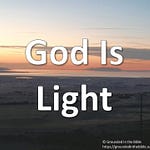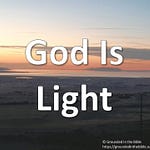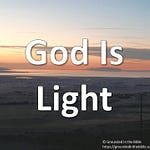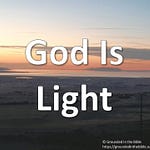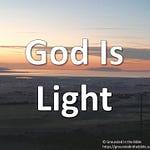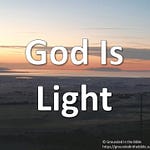If you want to receive Grounded in the Bible’s weekly Bible studies in your inbox each week, you can subscribe here! Join us as we "grow in the grace and knowledge of our Lord and Savior Jesus Christ."
Every Christmas Eve, our church ends our Christmas Eve service by singing Silent Night by candlelight. It’s one of many ways we use light to worship God. Those flickering flames of the candles remind us that Jesus came into the world to bring light to the darkness.
The Bible says that we are God’s “holy people in the kingdom of light” (Colossians 1:12). If we are part of the kingdom of light, it only makes sense that we use light to worship God.

What ways do you use light in your church to worship God? Maybe you have a light that shines on a cross. Maybe you use light to project the words to your worship songs. Maybe you use light to guide people’s eyes to the person who is teaching about God’s word.
The idea of using light to worship isn’t new. It didn’t begin with the invention of electricity. It began all the way back with the Israelites wandering in the wilderness. The Bible discusses two main ways that we can use light to worship: we can use light in God’s house to worship and we can use light to show that we are prepared for Christ’s return.
Light to Worship in the Tabernacle
When the Israelites were wandering in the wilderness, God gave them designs for a portable tabernacle that they could set up and take down so they would have a place of worship on their travels. One instruction God gave was to include a lampstand with seven lamps.
Exodus 25:31-40: 31 “Make a lampstand of pure gold. Hammer out its base and shaft, and make its flowerlike cups, buds and blossoms of one piece with them. 32 Six branches are to extend from the sides of the lampstand—three on one side and three on the other. 33 Three cups shaped like almond flowers with buds and blossoms are to be on one branch, three on the next branch, and the same for all six branches extending from the lampstand. 34 And on the lampstand there are to be four cups shaped like almond flowers with buds and blossoms. 35 One bud shall be under the first pair of branches extending from the lampstand, a second bud under the second pair, and a third bud under the third pair—six branches in all. 36 The buds and branches shall all be of one piece with the lampstand, hammered out of pure gold.
37 “Then make its seven lamps and set them up on it so that they light the space in front of it. 38 Its wick trimmers and trays are to be of pure gold. 39 A talent of pure gold is to be used for the lampstand and all these accessories. 40 See that you make them according to the pattern shown you on the mountain.”
The people were then to bring olive oil as part of their offerings so that the lamps could be kept burning.
Exodus 27:20-21: 20 “Command the Israelites to bring you clear oil of pressed olives for the light so that the lamps may be kept burning. 21 In the tent of meeting, outside the curtain that shields the ark of the covenant law, Aaron and his sons are to keep the lamps burning before the Lord from evening till morning. This is to be a lasting ordinance among the Israelites for the generations to come.”
The people completed all the work on the tabernacle and brought gifts just as God commanded, including making the lampstand and lamps and bringing olive oil for the light in the tabernacle. The priests kept the lamps burning as an act of worship to God throughout the entire night. This light joined the light from the pillar of fire in reminding the Israelites to keep their eyes on the place where God dwelled with them.
Light to Worship in the Temple
When the Israelites settled in the Promised Land, their third king, Solomon, decided to build a more permanent temple as a place to worship God. Once again, God gave him the specifications for building the temple, which included ten lampstands with their lamps.
1 Kings 7:48-50: 48 Solomon also made all the furnishings that were in the Lord’s temple:
the golden altar;
the golden table on which was the bread of the Presence;
49 the lampstands of pure gold (five on the right and five on the left, in front of the inner sanctuary);
the gold floral work and lamps and tongs;
50 the pure gold basins, wick trimmers, sprinkling bowls, dishes and censers;
and the gold sockets for the doors of the innermost room, the Most Holy Place, and also for the doors of the main hall of the temple.
2 Chronicles 4:7: He made ten gold lampstands according to the specifications for them and placed them in the temple, five on the south side and five on the north.
Similar to the tabernacle, the priests lit the lamps every evening to bring light to the temple.
2 Chronicles 13:10-11: 10 “As for us, the Lord is our God, and we have not forsaken him. The priests who serve the Lord are sons of Aaron, and the Levites assist them. 11 Every morning and evening they present burnt offerings and fragrant incense to the Lord. They set out the bread on the ceremonially clean table and light the lamps on the gold lampstand every evening. We are observing the requirements of the Lord our God. But you have forsaken him.”
This passage ends on a sad note. Within one generation of Solomon building the temple, the kingdom had split in two (Israel and Judah), and the people of Israel no longer worshipped God faithfully. The priests in Jerusalem continued to carry out their duties of lighting the lamps each evening, but it had no meaning for the majority of the Israelites.
What does this mean for us? We need to be cautious that we aren’t just going through the motions of worship. We can use light and songs and more during our worship time, but if that worship doesn’t reach our hearts, it’s not really worship.
Light to Be Prepared for Christ’s Return
Worship doesn’t only happen in a church building. It happens in our everyday lives as well. Jesus told two parables using light to tell us that as we go about our everyday lives, we need to be watchful and ready.
Matthew 25:1-13: 25 “At that time the kingdom of heaven will be like ten virgins who took their lamps and went out to meet the bridegroom. 2 Five of them were foolish and five were wise. 3 The foolish ones took their lamps but did not take any oil with them. 4 The wise ones, however, took oil in jars along with their lamps. 5 The bridegroom was a long time in coming, and they all became drowsy and fell asleep.
6 “At midnight the cry rang out: ‘Here’s the bridegroom! Come out to meet him!’
7 “Then all the virgins woke up and trimmed their lamps. 8 The foolish ones said to the wise, ‘Give us some of your oil; our lamps are going out.’
9 “‘No,’ they replied, ‘there may not be enough for both us and you. Instead, go to those who sell oil and buy some for yourselves.’
10 “But while they were on their way to buy the oil, the bridegroom arrived. The virgins who were ready went in with him to the wedding banquet. And the door was shut.
11 “Later the others also came. ‘Lord, Lord,’ they said, ‘open the door for us!’
12 “But he replied, ‘Truly I tell you, I don’t know you.’
13 “Therefore keep watch, because you do not know the day or the hour.”
Luke 12:35-40: 35 “Be dressed ready for service and keep your lamps burning, 36 like servants waiting for their master to return from a wedding banquet, so that when he comes and knocks they can immediately open the door for him. 37 It will be good for those servants whose master finds them watching when he comes. Truly I tell you, he will dress himself to serve, will have them recline at the table and will come and wait on them. 38 It will be good for those servants whose master finds them ready, even if he comes in the middle of the night or toward daybreak. 39 But understand this: If the owner of the house had known at what hour the thief was coming, he would not have let his house be broken into. 40 You also must be ready, because the Son of Man will come at an hour when you do not expect him.”
In these two parables, the virgins and the servants were given the responsibility of being ready for the bridegroom’s or the master’s coming. How did they show they were ready? They kept their lamps burning.
In the same way, as Christians we need to be ready for Christ’s return. How do we show we are ready and waiting?
Romans 13:12: The night is nearly over; the day is almost here. So let us put aside the deeds of darkness and put on the armor of light.
1 Thessalonians 5:4-8: 4 But you, brothers and sisters, are not in darkness so that this day should surprise you like a thief. 5 You are all children of the light and children of the day. We do not belong to the night or to the darkness. 6 So then, let us not be like others, who are asleep, but let us be awake and sober. 7 For those who sleep, sleep at night, and those who get drunk, get drunk at night. 8 But since we belong to the day, let us be sober, putting on faith and love as a breastplate, and the hope of salvation as a helmet.
We show we are ready for Christ’s return by being children of the light and putting on the armor of light—faith, love, and the hope of salvation. We stay watchful and sober, putting aside the deeds of darkness (sin) so that we can be ready at a moment’s notice. Living a life of light that shows we are ready for Christ’s return is a great way to worship God.
Conclusion
Using light for worship is one way that we can reflect God’s glory back to him. Light in a church building or worship service can direct people’s attention to God and his Word or it can guide people to have a heart of worship. In our everyday lives, we can reflect God’s light by putting off the deeds of darkness (sin) and putting on the armor of light (faith, love, and hope of salvation). The more we reflect God’s light, the greater our worship will be.
Premium Resources
Each individual characteristic of God study will come with two resources: a word search just for fun (including an answer key), and a list of verses for if you want to investigate that individual characteristic of God more completely.
You can access these resources by clicking here: God Is Light Resources
Or you can download them here:






